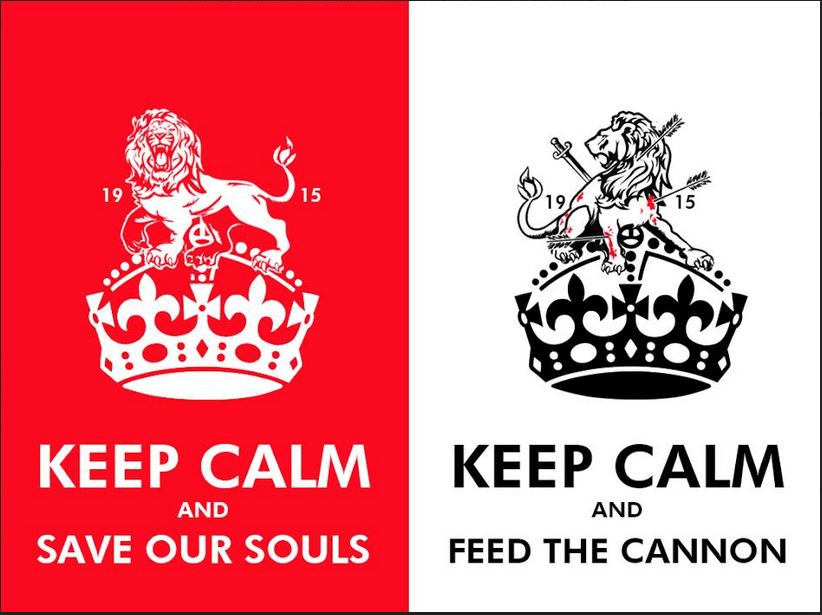
Lions to the Slaughter
WW1 Punjab’s Defenders of the Crown
On April 25 1915 an Allied force of 5 divisions, 4 British and 1 French, landed on the southern tip of Turkey’s Gallipoli peninsula. Commanded by General Sir Ian Hamilton their objective was to fight their way through all the way to Istanbul to take Germany’s key ally out of the war. Amongst this attacking force were 15,000 Indian infantry and artillery men. The plan, originally conceived earlier in 1915 as a diversion to ease pressure on the Russian forces in the Caucasus accounted for 2 Turkish divisions, but by the time of the landings both the plan and the challenge had burgeoned into an exercise in futility – the Turks had increased their strength to six divisions. Not only was the attacking force inferior in numbers, the situation on the ground favoured the Turks who were by now well dug in on the high ground. And so the stage was set for one of the most ill-fated campaigns of World War 1 – in the disaster that would follow nearly 25,000 British and Irish, over 7,200 of the Australian units, more than 2,300 of New Zealand’s forces, and more than 1,500 members of the Indian Army would be lost in one of Turkey’s greatest victories of the war.
During the campaign, on this day 100 years ago, June 4th 1915, Sir Ian Hamilton ordered a general attack to consolidate the Allied line. The 14th Sikhs part of the Indian brigade , fighting on the left flank of the British were assigned a frontage of about eight hundred yards of the allied front line, which lay astride a ravine in which the high ground was defended by two lines of Turkish trenches, known as J10 and J11. The ravine was about seventy-five yards wide and forty to fifty feet deep, the lower portion being covered with low scrub with the ground sloping gradually upward and eastward to crest line about two hundred yards away. There was every possibility of machine guns being hidden in positions on the sides commanding the approaches up the gully.
The Indian Brigade was ordered attack in two waves. The first wave was to capture the Turkish trench line J11 and consolidate its position there, while the second wave, starting fifteen minutes later, was to capture J13. Half of the 14th Sikhs were in the first wave and the other half in the second.
The following is the account of the events that followed the orders to go ‘over the top’, written by Lieut. R.A. Savory of No 4 Company 14th Sikhs who lived to tell the tale because of the gallant actions of a young Sikh that day.
“On 3rd June we received orders for general assault all along the line next day. The orders were short and clear. At 11 am on 4th June all the guns were to bombard the enemy’s front line trenches for twenty minutes. Then for ten minutes they were to stop while the infantry were to cheer and wave their bayonets. The object of this was to persuade the enemy to man their parapets. Then the bombardment was to come down again. At noon we were to advance. It all sounded simple enough. The 14th Sikhs were to attack astride the Gully Ravine.
>
“The 4th of June was a beautiful summer day. Our guns started registering at 8 am and even before the bombardment began it must have been clear to the enemy that something was about to happen. “It was now 11.30 am and time for the cheering to start; but the noise was so great that we could hardly hear it even in our own trench. And then-twelve noon – blew the whistle – and we were away. From that moment I lost all control of the fighting. The roar of musketry drowned every other sound, except that of the guns. To try to give an order was useless. The nearest man was only a yard or two away but I couldn’t see him. Soon I found myself running on alone, except for my little bugler, a young, handsome boy, just out of his teens, who came paddling along behind me to act as a runner and carry messages. Poor little chap.
“During the first few minutes, I was knocked out, lying on the parapet with two Turks using my body as a rest over which to shoot at our second line coming forward. When I fully recovered consciousness, the Turks had gone. I looked around and saw my little bugler lying dead, brutally mutilated. I could see no one else, stumbled back as best I could, my head was bleeding and I was dazed and then, Udai Singh, a great burly Sikh with a fair beard who was one of our battalion wrestlers, came out of the reserve trenches, picked me up, slung me over his shoulder, and brought me to safety; and all the time we were being shot at.”
<<
In charging the trenches, an action that became known as the 3rd battle of Krithia, the 14th Sikhs lost 80% of their battalion, three hundred and seventy-one officers and men killed or wounded. Writing to the Commander-in-Chief in India a few weeks after the event, General Sir Ian Hamilton paid tribute to the heroism of all ranks.
"In the highest sense of the word extreme gallantry has been shown by this fine Battalion..... In spite of the tremendous losses there was not a sign of wavering all day. Not an inch of ground gained was given up and not a single straggler came back. The ends of the enemy's trenches leading into the ravine were found to be blocked with the bodies of Sikhs and of the enemy who died fighting at close quarters, and the glacis slope was thickly dotted with the bodies of these fine soldiers all lying on their faces as they fell in their steady advance on the enemy. The history of the Sikhs affords many instances of their value as soldiers, but it may be safely asserted that nothing finer than the grim valour and steady discipline displayed by them on the 4th June has ever been done by soldiers of the Khalsa. Their devotion to duty and their splendid loyalty to their orders and to their leaders make a record their nation should look back upon with pride for many generations."
After the battle Lieut. Savory who had not been wounded badly, and was the only officer left in the Battalion, took over the command. Savory who was deeply indebted to Udai Singh for saving his life called him one day and said, "What can I do for you Udai Singh?" He in fact wanted to get Udai a gallantry award. But Udai Singh's mind quickly flew back to his native village in Punjab.
"I would like to be discharged, Sahib", replied Udai Singh. "That is not possible, the war is on. I want to get you something big," said Savory. "Then you can keep your offer to yourself, Sahib I am not interested in anything else," answered Udai Singh in a rather angry tone. Very reluctantly, and against his better judgement, Savory got Udai Singh his discharge to return to his village and family.
( see http://sikhchic.com/history/the_saga_of_udai_singh for the full the story of Udia Singh)
Charging uphill, taking on well entrenched forces, as the 14ths Sikhs did on June 4th were either very brave or foolhardy actions. Were these then the actions of blind servitude to the British - were these men fools fighting towards their own subjugation? It's hard to reconcile the basis of these epic actions as those borne of such cowering temperaments. These men stood proud on the shoulders of other great men that had gone before them - the 14th Sikhs traced their bloodlines to the glorious Khalsa Forces of the Sikh Kingdom of Punjab, and had won the honour beyond all others to be called "King George's Own" 14th Sikhs.
During our November 2015 Public Lecture at Simon Fraser University, Major Corrigan ex-Gurkha officer made clear the level of professionalism of the Sikhs and Ghurkhas in Gallipoli " at times they were the only ones that knew what they were doing” reported the good major. Not only did they know what they were doing they had the strength of will to carry out an against all odds action - it is clear these were men of infinite courage. Losing most of their battalion was always on the cards yet they still did it - facing forward not one turned their back on their duty and comrades, rushing onwards they succeeded in taking the trenches.
Over the last century, many acts of courageous and gallant Punjabis have been rendered through a lens of a variety of political hues to denigrate these proud men as fools , slaves and war mongers. The actions of the 14th Sikhs on June the 4th at Gallipoli are not an isolated incident , but rather compromise the latest chapter in a series of great tales of courage, that we have covered in our posts at www.imfc.org :
The 15th Sikhs at Festubert on May 18th https://www.facebook.com/IndusMediaFoundation/posts/704915416303915:0
The 47th Sikhs on April 26th at 2nd Ypres
https://www.facebook.com/IndusMediaFoundation/posts/698968863565237
The story of Manta Singh at Neuve Chappell on March 20th 1915 http://imfc.org/manta/ - risking his life for his British officer
Perhaps after 100 years, it is time to remember these men as those that held themselves to a higher standard of honour and duty than their detractors - rather than lambs led to the slaughter they were the proverbial 'lions that rushed to the roaring slaughter'. They had been tasked by India to shoulder the burden of war equally with the white Dominions in order to sit as equals under one crown. Their duty was clear, they went to war with their eyes wide open. They charged against all odds with every intention of seizing the day, so that when the time came to be counted, mother India could hold her head up high on the global stage - in a world that would be redefined by the events of the first world war.
Thankfully, there are encouraging signs that on this centennial Australians are waking up to the fact that Indian soldiers stood beside them in a seminal moment in their history : http://www.abc.net.au/…/20…/indias-role-at-gallipoli/6417326
Here in Canada, we ask you to support us by sharing our posts with friends & relatives so that we too can raise awareness of our heroes lost to time, men that stood in Canada's Gallipoli - Flanders Fields - the Punjabis that fought alongside Canadians on the Western Front. While they were men for whom death held no fear, they still cherished life; like Udia Singh they all wanted to live, to above all else be reunited with their families back home in villages far from the battlefield. For that their sacrifices should be recognised , their courage respected , their lives remembered.
#Rememberthem
#Sikhs #Sikh #Punjab #Panjab #Panjabi #Punjabi #FirstWorldWar #WW1 #Indian #GreatWar #1914 #1915 #Festubert #ww1centennial #Ypres #Gallipoli #Neuvechapelle #indocanadians #indocanadian #canadianhistory #sikhhistory #canadiansikhs #southasians

